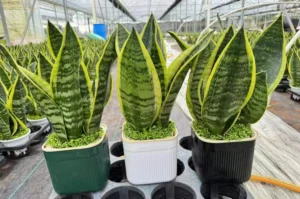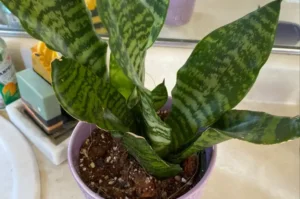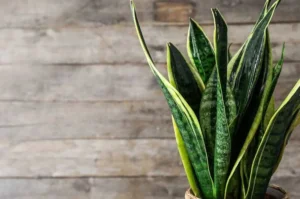If you’re a fan of low-maintenance houseplants, chances are you already love the hardy, air-purifying snake plant. Known for its upright, sword-like leaves and resilience, the snake plant (Sansevieria) thrives on neglect and looks great in almost any room. But what if we told you it could look even better when paired with the right plant companions?
Creating a mixed indoor garden with snake plants as the centerpiece isn’t just visually appealing; it also helps improve indoor air quality and boosts your home’s natural ambiance. Here are eight houseplants that pair beautifully with snake plants, creating a dynamic and lush display for your home.
1. ZZ Plant (Zamioculcas zamiifolia)
If you love the snake plant for its toughness, you’ll adore the ZZ plant. With thick, glossy green leaves and a similar preference for indirect light and minimal watering, ZZ plants make a perfect companion. Both plants can survive in low light and don’t need frequent attention, making them ideal for busy plant parents or beginners.
Why it works:
- Similar care needs
- Aesthetic contrast: broad, glossy leaves vs. tall, structured snake plant leaves
2. Pothos (Epipremnum aureum)
Often called the “devil’s ivy,” pothos is one of the most popular houseplants for a reason. It’s forgiving, fast-growing, and comes in various variegated patterns. While the snake plant grows upright, pothos trails and drapes, adding softness and movement to your plant display.
Why it works:
- Trailing habit complements vertical snake plants
- Thrives in similar light and humidity conditions
- Easy to propagate and share
3. Peace Lily (Spathiphyllum)
If you want to add some flowering charm to your snake plant corner, the peace lily is a top contender. Its dark green leaves and occasional white blooms offer a soothing contrast to the rigidity of snake plants. Both do well in low to moderate light, but peace lilies like slightly more moisture.
Care tip:
Let the peace lily dry out slightly between waterings, but don’t let it get as dry as a snake plant.
Why it works:
- Air-purifying properties
- Brings color and bloom to the mix
- Elegant visual pairing
4. Spider Plant (Chlorophytum comosum)
Known for its arching leaves and “baby” plantlets, the spider plant is a classic indoor favorite. It’s another low-maintenance houseplant that complements the snake plant’s structure with its fountain-like growth.
Why it works:
- Variegated leaves contrast beautifully
- Pet-safe (if you have cats or dogs)
- Adds volume to your plant setup
5. Aloe Vera
Like snake plants, aloe vera is a succulent that thrives on neglect. Its thick, spiky leaves offer a desert-like appeal that blends well with the architectural look of snake plants. Plus, aloe has soothing properties and can be used for minor burns and skin irritations.
Why it works:
- Minimal watering needed
- Similar light preferences (bright, indirect light)
- Useful and beautiful
6. Chinese Evergreen (Aglaonema)
Looking to add a pop of color to your snake plant display? Chinese evergreens come in stunning patterns of silver, red, pink, and green. They’re adaptable and tolerant of low light, just like snake plants.
Why it works:
- Colorful foliage adds variety
- Same low-maintenance lifestyle
- Works well in shaded corners
7. Cast Iron Plant (Aspidistra elatior)
True to its name, the cast iron plant is nearly indestructible. It grows slowly and steadily, tolerating low light, temperature changes, and neglect, just like the snake plant. It features long, dark green leaves that add depth to any plant collection.
Why it works:
- Extremely durable
- Complementary growth habit
- Excellent for the darker corners of your home
8. Rubber Plant (Ficus elastica)
For a bold, modern indoor jungle look, consider the rubber plant. Its large, glossy leaves add height and drama to your collection. While it prefers more light than snake plants, it can still tolerate indirect sunlight and thrives in similar temperatures.
Why it works:
- Adds height and structure
- Deep green or burgundy tones look striking next to snake plants
- Low to moderate maintenance
Tips for Growing a Mixed Indoor Garden with Snake Plants
Creating a successful indoor garden isn’t just about mixing pretty plants, it’s about matching care needs. Here’s how to keep your leafy companions happy together:
- Light: Most plants on this list do well in low to medium indirect light. Avoid placing them in direct sunlight unless acclimated.
- Water: Snake plants prefer dry soil, while others (like peace lilies) need a bit more moisture. Group plants with similar watering needs together.
- Containers: Choose pots with drainage holes to prevent root rot, and consider grouping your plants in similar-colored or textured pots for a cohesive look.
- Humidity: Most of these plants do well in average indoor humidity, but misting occasionally can benefit species like the spider plant and Chinese evergreen.
Final Thoughts
Snake plants are fantastic on their own, but when you pair them with the right plant partners, you create a mini ecosystem that’s both functional and beautiful. Whether you’re designing a cozy bedroom nook, a lush bathroom corner, or a green-filled living room shelf, combining snake plants with other houseplants can elevate your indoor garden to new heights.
So the next time you’re at the garden center or shopping online for a new green friend, consider one of these eight snake plant companions. Your home and your snake plants will thank you.






